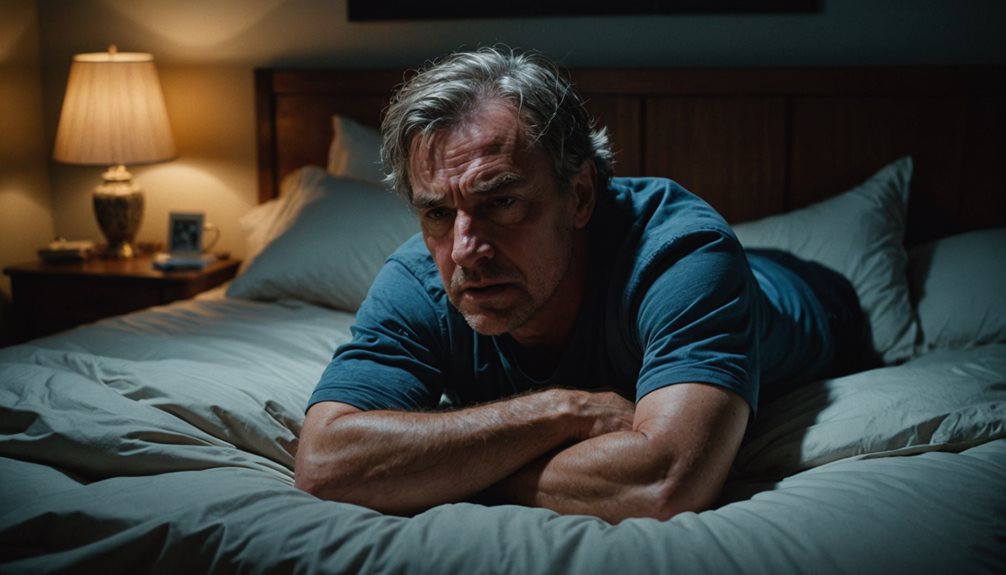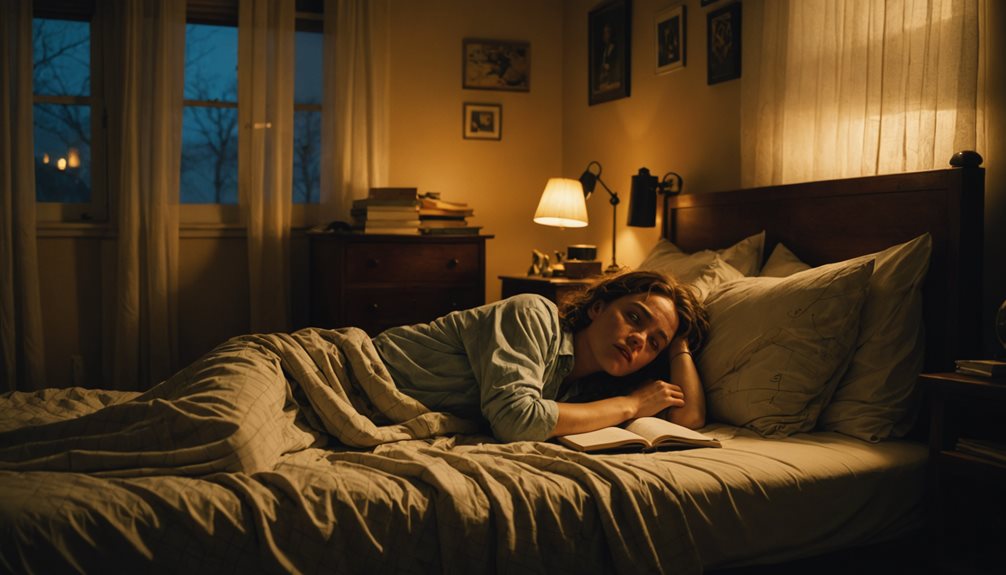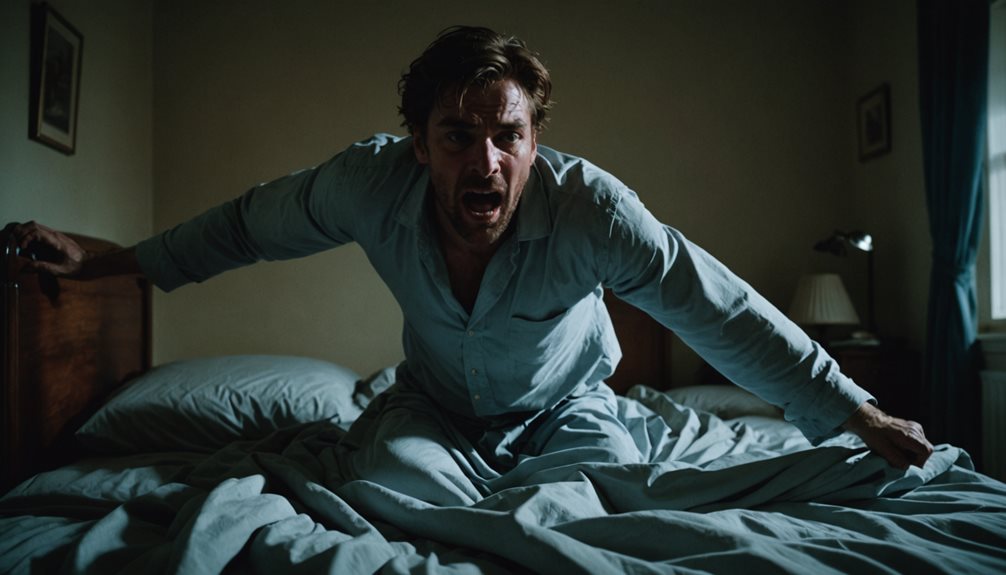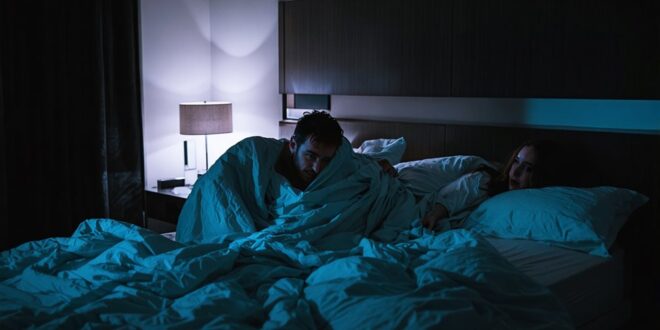If you find yourself or someone you care about thrashing, kicking, or even shouting during the night, it might be more than just a bad dream. With REM Sleep Behavior Disorder, your body fails to stay still during REM sleep, letting you physically act out your dreams—sometimes with surprising force. But what really sets this apart from other sleep issues? That one detail might change what you think about those restless nights.
Key Takeaways
- Sudden, forceful movements during sleep, such as kicking or punching, often occur.
- Vocalizations like talking, shouting, laughing, or swearing frequently happen during episodes.
- Individuals often recall vivid, intense dreams associated with their actions upon awakening.
- Bed partners may experience sleep disturbances or injuries from the affected individual’s movements.
- The physical behaviors occur because normal muscle paralysis during REM sleep fails.
Understanding REM Sleep Behavior Disorder

During rapid eye movement (REM) sleep, the body is typically immobilized to prevent movement.
In REM Sleep Behavior Disorder (RBD), this muscle paralysis doesn’t occur, resulting in individuals physically acting out their dreams. These actions can include movements such as kicking, punching, or making vocal sounds corresponding to dream content.
RBD is most frequently diagnosed in older men, though it can also develop in women or younger individuals, particularly those with pre-existing neurological conditions.
One distinguishing feature of RBD is the tendency to remember dreams associated with these episodes. This clinical presentation allows RBD to be differentiated from other sleep-related disorders.
Common Physical Symptoms During Sleep
When muscle paralysis doesn’t occur during REM sleep, individuals may experience sudden, forceful movements such as kicking, punching, or leaving the bed in response to dream content.
These behaviors are characteristic of REM sleep behavior disorder (RBD). Dream enactment associated with RBD can sometimes lead to physical injuries, including bruises, cuts, or, in more severe cases, fractures.
Individuals often have clear recall of their dreams during these episodes, which distinguishes RBD from other sleep disorders.
The frequency and intensity of these physical symptoms can increase over time, elevating the risk of injury if the condition is left unaddressed.
Vocalizations and Noises Associated With RBD
During episodes of REM sleep behavior disorder (RBD), individuals often produce vocalizations that reflect the emotions and scenarios occurring within their dreams.
These sounds can include talking, shouting, laughing, or swearing, and may range from soft murmurs to louder outbursts. Such vocalizations, along with accompanying physical movements, can disturb bed partners and occasionally lead to distress or embarrassment.
Typically, affected individuals aren’t aware of these noises during the episodes, but they’re frequently observed and reported by bed partners. The presence of vocalizations is an important clinical indicator for identifying RBD and is often used in conjunction with other behavioral symptoms during assessment.
Early recognition of these vocal behaviors can contribute to timely and accurate diagnosis.
Dream Recall After Episodes

In REM sleep behavior disorder, individuals commonly exhibit vocalizations and physical movements during sleep.
These episodes are often accompanied by an increased ability to recall dreams upon awakening. The dream recall tends to be clear and detailed, frequently involving content that’s vivid and sometimes disturbing.
This pattern of dream recall distinguishes REM sleep behavior disorder from other sleep disorders, where recollection of dreams is less common.
The detailed nature of these memories can be useful for clinical assessment, as the information shared with healthcare providers may assist in the accurate diagnosis and management of the condition.
Frequency and Severity of Episodes
REM sleep behavior disorder (RBD) commonly begins with infrequent episodes but tends to show an increase in both frequency and severity over time.
As the condition progresses, individuals may experience a transition from minor movements during sleep to more pronounced actions such as punching or kicking. These behaviors can result in sleep-related injuries, which are reported by approximately 80% of individuals diagnosed with RBD.
Many affected individuals are able to recall vivid, often intense dreams that correspond to their physical actions during these episodes, suggesting a direct relationship between dream content and motor activity.
An increase in the frequency and intensity of episodes can significantly disrupt sleep quality and may negatively affect overall health and safety.
Impact on Bed Partners and Living Environment
As episodes of REM sleep behavior disorder (RBD) become more frequent and severe, the impacts can extend beyond the individual affected to those who share a living environment.
Violent movements during sleep associated with RBD may result in injuries to bed partners; research indicates that more than half of partners report physical harm and most experience sleep disturbances.
These disruptions can negatively affect shared sleeping arrangements and place strain on relationships.
Often, bed partners are the first to notice the symptoms of RBD, as affected individuals may be unaware of their behavior.
Implementing safety measures in the sleeping environment is therefore important to reduce the risk of injuries and promote safety for all occupants.
Why Muscle Paralysis Fails During REM Sleep

During REM sleep, the body typically experiences a state known as atonia, in which most skeletal muscles are temporarily paralyzed. This physiological response prevents individuals from physically enacting their dreams.
In cases of REM sleep behavior disorder, this muscle paralysis doesn’t function as intended. The failure of atonia is primarily linked to disruptions in neural pathways within the brainstem, especially in an area called the pons. The pons is integral to the regulation of REM sleep and muscle inhibition.
When these pathways are impaired, the muscles can remain active, leading to movements that correspond with dream content. Consequently, individuals with REM sleep behavior disorder may display physical activity such as kicking, punching, or leaving the bed, typically in response to vivid or intense dreams.
Distinguishing RBD From Other Sleep Disorders
REM sleep behavior disorder (RBD) is characterized by the loss of normal muscle paralysis during REM sleep, which allows individuals to physically act out their dreams. This can involve movements that may appear abrupt or potentially injurious.
RBD is differentiated from other sleep disorders in several distinct ways. For example, unlike sleepwalking—which occurs during non-REM sleep and is generally not accompanied by dream recall—RBD usually involves vivid dream enactment with subsequent recall.
The absence of muscle atonia during REM sleep in RBD is a key physiological marker. Additionally, RBD has a notable association with neurodegenerative diseases such as Parkinson’s disease, which sets it apart from conditions like insomnia or restless legs syndrome that don’t share this connection.
Identifying these clinical features is important for accurate diagnosis and management.
When to Seek Medical Attention for Symptoms
If you experience repeated episodes of violent movements or vocalizations during sleep, these may be indicators of REM sleep behavior disorder (RBD) and should be evaluated by a healthcare professional.
Episodes that lead to injury for yourself or your bed partner, or that are associated with vivid dream recall, warrant medical attention. A higher frequency of episodes—especially if they occur several times per week—suggests the need for assessment by a sleep specialist for accurate diagnosis and management.
Additionally, the appearance of new symptoms such as changes in movement, cognitive function, or increased daytime sleepiness may indicate an underlying neurological disorder and should prompt further medical evaluation.
Prompt consultation ensures appropriate investigation and care.
 Mindful Vitals This is a blog about health.
Mindful Vitals This is a blog about health.

